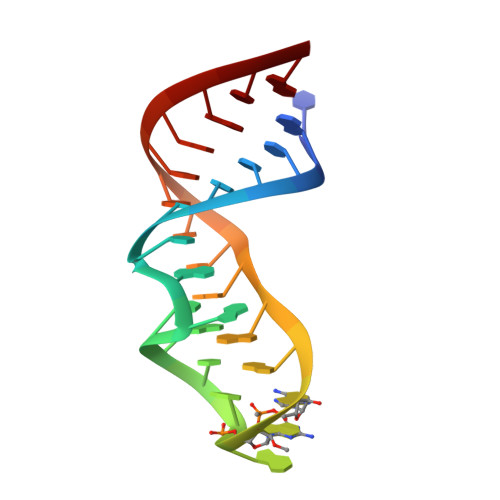Role of a ribosomal RNA phosphate oxygen during the EF-G-triggered GTP hydrolysis.
Koch, M., Flur, S., Kreutz, C., Ennifar, E., Micura, R., Polacek, N.(2015) Proc Natl Acad Sci U S A 112: E2561-E2568
- PubMed: 25941362
- DOI: https://doi.org/10.1073/pnas.1505231112
- Primary Citation of Related Structures:
4Y27 - PubMed Abstract:
Elongation factor-catalyzed GTP hydrolysis is a key reaction during the ribosomal elongation cycle. Recent crystal structures of G proteins, such as elongation factor G (EF-G) bound to the ribosome, as well as many biochemical studies, provide evidence that the direct interaction of translational GTPases (trGTPases) with the sarcin-ricin loop (SRL) of ribosomal RNA (rRNA) is pivotal for hydrolysis. However, the precise mechanism remains elusive and is intensively debated. Based on the close proximity of the phosphate oxygen of A2662 of the SRL to the supposedly catalytic histidine of EF-G (His87), we probed this interaction by an atomic mutagenesis approach. We individually replaced either of the two nonbridging phosphate oxygens at A2662 with a methyl group by the introduction of a methylphosphonate instead of the natural phosphate in fully functional, reconstituted bacterial ribosomes. Our major finding was that only one of the two resulting diastereomers, the SP methylphosphonate, was compatible with efficient GTPase activation on EF-G. The same trend was observed for a second trGTPase, namely EF4 (LepA). In addition, we provide evidence that the negative charge of the A2662 phosphate group must be retained for uncompromised activity in GTP hydrolysis. In summary, our data strongly corroborate that the nonbridging proSP phosphate oxygen at the A2662 of the SRL is critically involved in the activation of GTP hydrolysis. A mechanistic scenario is supported in which positioning of the catalytically active, protonated His87 through electrostatic interactions with the A2662 phosphate group and H-bond networks are key features of ribosome-triggered activation of trGTPases.
Organizational Affiliation:
Department of Chemistry and Biochemistry, University of Bern, 3012 Bern, Switzerland;














